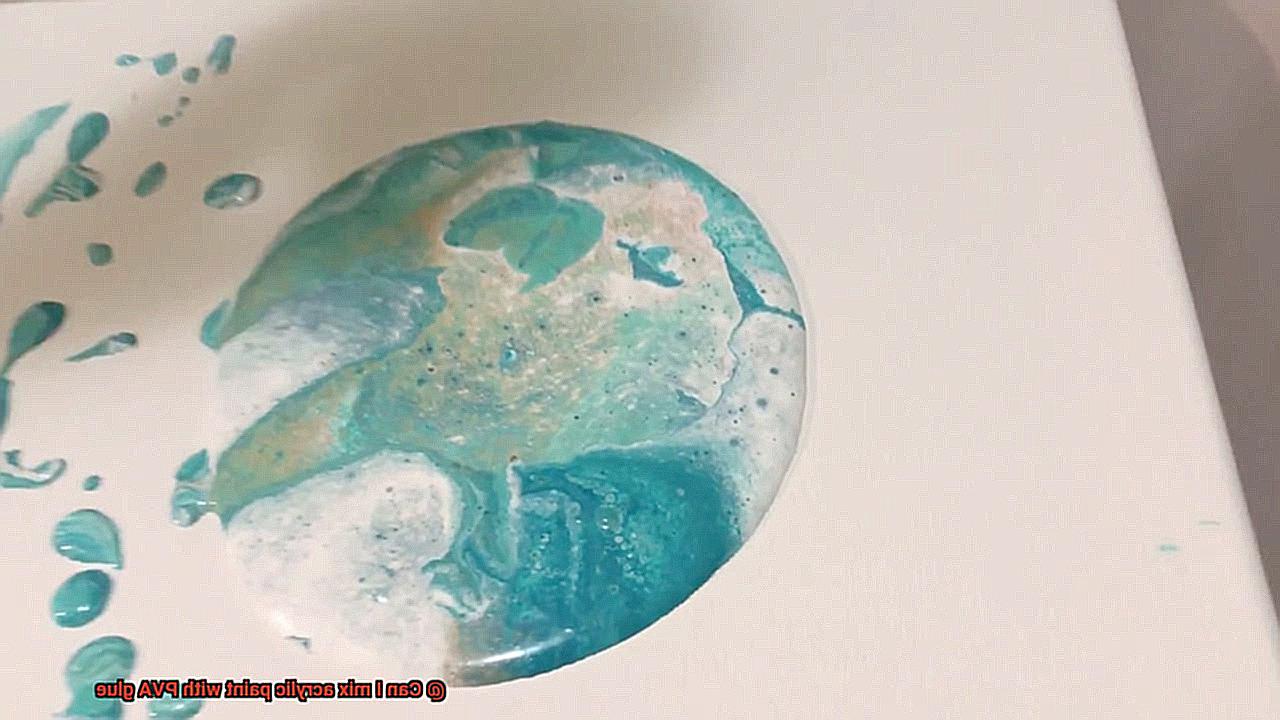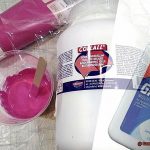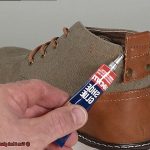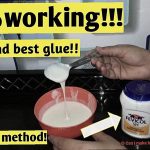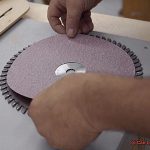Well, hold on tight because today we’re diving headfirst into the thrilling realm of mixing acrylic paint with PVA glue. Yep, we’re about to unleash the hidden powers of this dynamic duo.
Now, you might be wondering: can acrylic paint and PVA glue really play nice together? Can they create mind-blowing textures, add depth to your masterpieces, or even save you some cash?
Buckle up as we uncover all the answers and unlock the secrets behind this unexpected partnership.
What is Acrylic Paint?
Contents
- 1 What is Acrylic Paint?
- 2 What is PVA Glue?
- 3 Advantages of Mixing Acrylic Paint and PVA Glue
- 4 Disadvantages of Mixing Acrylic Paint and PVA Glue
- 5 Ratio for Mixing Acrylic Paint and PVA Glue
- 6 Uses for the Mixture of Acrylic Paint and PVA Glue
- 7 Tips for Working with the Mixture of Acrylic Paint and PVA Glue
- 8 Clean Up After Using the Mixture of Acrylic Paint and PVA Glue
- 9 Conclusion
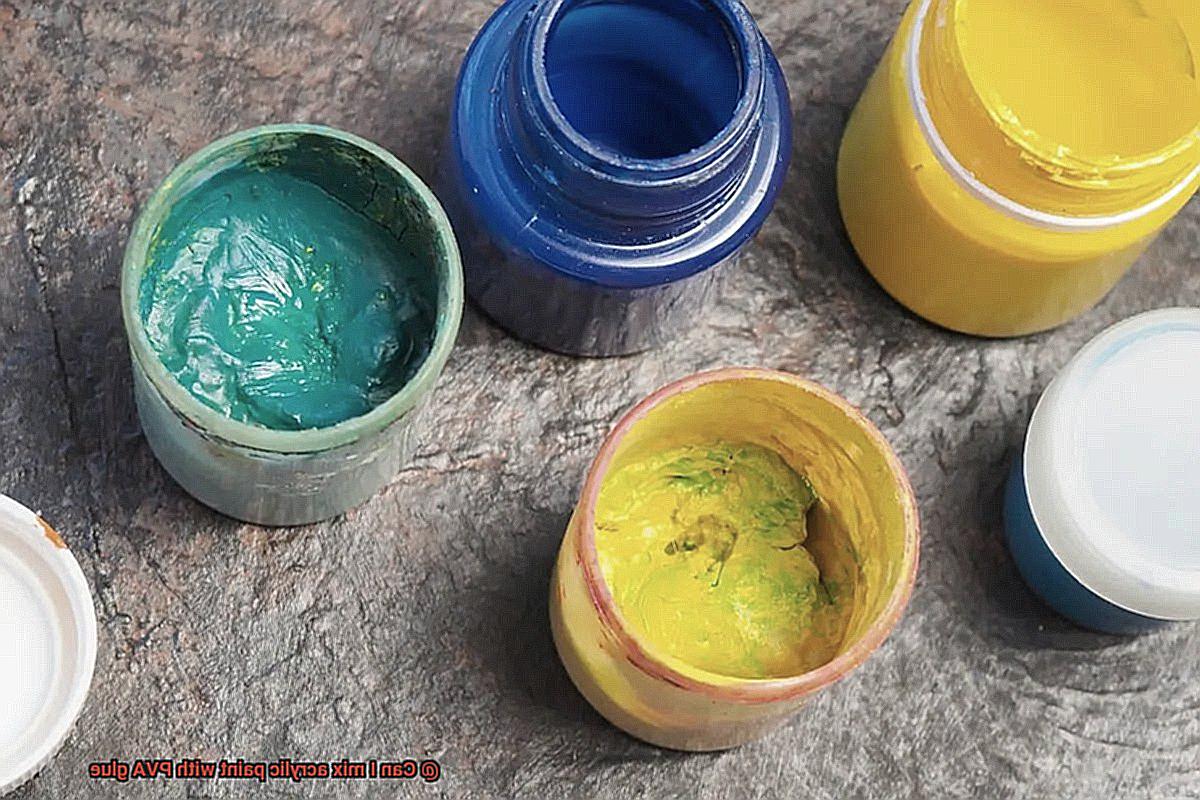
Acrylic paint is a versatile and popular medium used by artists of all skill levels. It is made up of pigment particles suspended in an acrylic polymer emulsion, giving it unique properties that set it apart from other types of paint.
One of the key characteristics of acrylic paint is its fast-drying nature. Unlike oil paints that can take days or even weeks to dry, acrylic paint dries relatively quickly. This is because the water in the emulsion evaporates, leaving behind a solid layer of pigment on the surface. This fast drying time allows artists to work more efficiently and build up layers of paint without waiting for extended drying periods.
Another advantage of acrylic paint is its ability to adhere well to a variety of surfaces. It can be applied to canvas, paper, wood, metal, plastic, and many other materials. This versatility makes it a popular choice for artists who like to experiment with different surfaces and mixed media techniques.
Acrylic paint also offers a wide range of colors and finishes. It comes in a variety of shades, from vibrant and bold to more muted and earthy tones. Additionally, artists can choose between matte, satin, and glossy finishes depending on the desired effect. This wide range of colors and finishes allows artists to create diverse and visually appealing artworks.
One of the reasons why acrylic paint is so popular among artists is its versatility in terms of application techniques. It can be applied with brushes, palette knives, sponges, or even sprayed onto a surface. Artists can create smooth and precise details or build up thick layers for texture and depth. This flexibility in application techniques allows artists to explore various artistic styles and achieve different effects.
Furthermore, acrylic paint is known for its excellent lightfastness. This means that the colors will not fade or change significantly over time when exposed to light. This ensures that artworks created with acrylic paint will maintain their original vibrancy for years to come.
What is PVA Glue?
PVA glue, also known as Polyvinyl Acetate glue, is a versatile adhesive that is commonly used in arts and crafts projects. This water-based glue is highly regarded for its strong bonding properties and ease of use.
Let’s delve into the key points about PVA glue:
- Adhesion: PVA glue is capable of adhering to a wide range of materials, including paper, fabric, wood, and certain plastics. This makes it an excellent choice for various crafts and DIY projects.
- Easy application: PVA glue comes in a liquid form that can be applied with ease. It can be brushed on, spread with a spatula, or even squeezed from a bottle with a precision tip. The versatility in application methods allows for creative freedom.
- Clear drying: A notable advantage of PVA glue is its ability to dry clear. This attribute makes it perfect for projects where you want the adhesive to remain invisible. Paper crafts, collages, and other applications where aesthetics matter greatly benefit from this feature.
- Fast drying time: PVA glue has a relatively quick drying time, minimizing the waiting period for your project to be completed. However, it is important to note that drying time may vary depending on the thickness and amount of glue applied.
- Flexibility: Once dry, PVA glue remains flexible and does not become brittle. This characteristic makes it an ideal choice for projects that require some movement or flexibility, such as bookbinding or fabric crafts.
- Non-toxic and safe: PVA glue is generally considered non-toxic and safe to use. However, it is always crucial to read the instructions and adhere to proper safety precautions when using any type of adhesive.
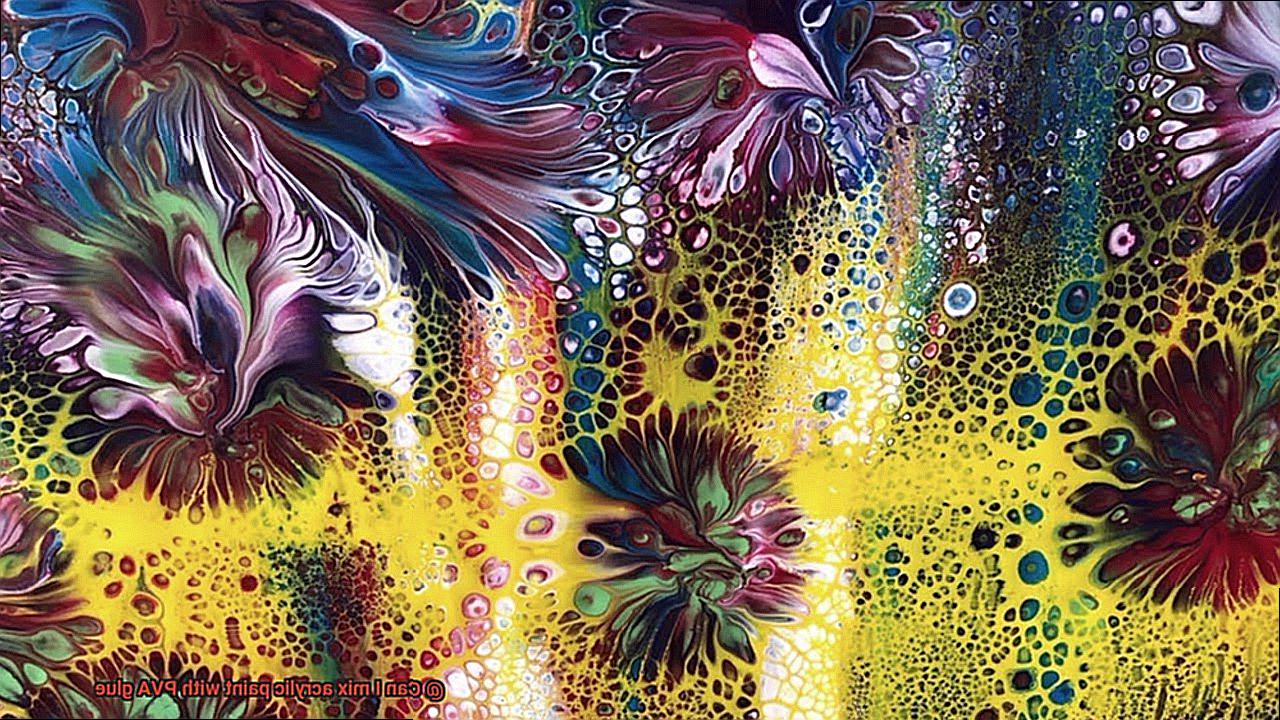

Advantages of Mixing Acrylic Paint and PVA Glue
Mixing acrylic paint and PVA glue offers a multitude of advantages for artists and crafters alike. The combination of these two materials unleashes a whole new realm of possibilities in painting techniques and artistic expression.
First and foremost, the addition of PVA glue significantly improves the adhesion of acrylic paint to various surfaces. Acting as a binder, the glue creates a strong bond between the paint and the canvas or other porous materials, ensuring that the artwork does not easily chip or peel off. This is particularly advantageous when working on wood or canvas surfaces, where adhesion is crucial for long-lasting artwork.
Another advantage of this mixture is the increased flexibility it provides to the paint film. Acrylic paint on its own can become brittle over time, especially when applied in thick layers. However, when mixed with PVA glue, the paint gains elasticity, allowing it to withstand movement and changes in temperature without cracking. This ensures that your artwork remains intact and visually appealing for years to come.
Additionally, mixing acrylic paint with PVA glue extends the drying time of the paint. Acrylics are notorious for their quick drying nature, which can make it challenging to blend colors or create smooth transitions. By incorporating PVA glue into the mix, artists gain more time to work with the paint and achieve desired effects like glazing or wet-on-wet painting. This extended drying time opens up a world of possibilities for creating intricate details and seamless color gradients in your artwork.
From a practical standpoint, blending acrylic paint with PVA glue can be cost-effective. Acrylic paints can be quite expensive, especially high-quality brands. By adding PVA glue to the mix, artists can extend the volume of their paint without compromising quality. This is particularly useful for large-scale projects or when working on a tight budget.
Furthermore, this mixture offers exciting textural effects. Adjusting the ratio of paint to glue allows artists to create thicker and more viscous mixtures, perfect for achieving impasto or textured surfaces. These textural effects add depth and dimension to paintings, making them visually captivating and allowing artists to explore new artistic horizons.
Lastly, mixing acrylic paint with PVA glue improves coverage. Transparent or semi-transparent colors can sometimes be challenging to apply evenly and achieve solid and vibrant results. However, the addition of PVA glue increases the opacity of the paint, making it easier to achieve full coverage in fewer layers. This is particularly advantageous when working on dark or colored backgrounds, where achieving solid colors can be a struggle.
Disadvantages of Mixing Acrylic Paint and PVA Glue
When it comes to mixing acrylic paint and PVA glue, there are several disadvantages that artists should consider. These disadvantages include a weaker and less durable paint film, altered drying time, potential color and texture alteration, compromised archival quality, and lack of protection against environmental factors.
Firstly, PVA glue is not specifically designed for use with acrylic paint, which can result in a weaker and less durable paint film. Unlike professional-grade acrylic mediums that provide excellent adhesion and flexibility, PVA glue may not offer the same level of quality. This can lead to issues such as cracking, flaking, or peeling of the paint over time.
Additionally, mixing PVA glue with acrylic paint can alter the drying time of the paint. Acrylic paint is known for its relatively quick drying time, allowing artists to work in layers or make adjustments without waiting for extended periods. However, adding PVA glue to the mix can slow down the drying process. This can make it more challenging to achieve desired effects or work on multiple layers since you may need to wait longer for each layer to dry before continuing.
Moreover, PVA glue can slightly alter the color and texture of the paint. While it dries clear, it has a milky appearance when wet and can affect the hue of the paint. This can be problematic when trying to achieve specific color mixing or desired shades. Furthermore, mixing PVA glue with acrylic paint can result in a thicker and more viscous consistency. While this may be desirable for certain painting techniques or applications, it may not work well for others.
Another disadvantage of mixing acrylic paint with PVA glue is compromised archival quality. Professional-grade acrylic paints are formulated to be lightfast and durable over time. However, introducing PVA glue into the mix may compromise the longevity and stability of the artwork. This could result in color fading or degradation over time.
Lastly, using PVA glue as a medium for acrylic paint may not provide the same level of protection against environmental factors. Professional-grade mediums are specifically designed to enhance the durability and longevity of the artwork, providing a protective barrier against moisture and UV radiation. On the other hand, PVA glue does not offer the same level of protection. This can leave the artwork more vulnerable to damage and degradation over time.
Ratio for Mixing Acrylic Paint and PVA Glue
When it comes to mixing acrylic paint and PVA glue, finding the right ratio is like uncovering a hidden treasure. It takes patience, experimentation, and a keen eye for detail. The ratio refers to the proportion of paint to glue that should be mixed together, and it can vary depending on the project at hand.
To start your artistic journey, begin with equal parts of acrylic paint and PVA glue. Picture this: you have 1 tablespoon of vibrant paint in one hand and 1 tablespoon of smooth glue in the other. Combine them in a harmonious dance, blending them until they become one unified mixture.
But wait. Your masterpiece may need some adjustments. The consistency you desire will guide you on this artistic voyage. If your mixture seems too thick, add a small splash of water to thin it out, like a gentle rain shower that rejuvenates the earth. On the other hand, if the mixture appears thin and runs away like a mischievous river, add more paint or glue to thicken it up, providing a solid foundation for your creative vision.
Ah, but let us not forget about the brands and quality of our materials. Different brands of acrylic paint and PVA glue have their own unique characteristics, like individuals with distinct personalities. Some paints may be thicker or more pigmented, requiring more or less glue to strike the perfect balance.
Furthermore, consider the purpose of your mixture. If you are using it as a base coat or primer, a thinner consistency may be desired, effortlessly gliding across your canvas like silk on skin. However, if you seek intricate details or a luxurious topcoat, a thicker mixture will provide the texture and coverage you crave.
In this artistic endeavor, there are no shortcuts or easy answers. Embrace experimentation and testing as your trusted companions. Be fearless in trying different ratios and making adjustments until your creation speaks to your soul. Remember to conduct small tests before applying the mixture to your final piece, ensuring it meets your expectations.
Uses for the Mixture of Acrylic Paint and PVA Glue
The mixture of acrylic paint and PVA glue is a versatile combination that has numerous uses in the world of art and crafts. Here are some specific applications for this mixture:
- Creating texture in paintings: By adding PVA glue to acrylic paint, artists can achieve a thicker consistency that allows for building up layers and creating three-dimensional effects on the canvas. This technique is particularly popular in abstract and mixed media art.
- Adhering materials in collages: Combining acrylic paint with PVA glue allows artists to securely adhere different materials such as paper, fabric, or found objects to their artwork. The glue acts as an adhesive, ensuring that the added elements stay in place. This technique opens up endless possibilities for creativity and experimentation.
- Decoupage projects: Decoupage involves cutting out images or designs from paper or fabric and gluing them onto a surface to create a decorative effect. Mixing acrylic paint with PVA glue allows artists to create a custom-colored adhesive that not only adheres the cut-outs but also acts as a protective sealant once dry.
- Homemade paints and dyes: By combining acrylic paint with PVA glue, artists can create water-based paints suitable for various surfaces such as paper, wood, or canvas. This homemade paint dries quickly and can be easily washed off hands and brushes with water. It provides a cost-effective alternative to store-bought paints and allows artists to customize colors according to their preferences.
- Fabric painting: Mixing acrylic paint with PVA glue creates a fabric medium that makes the paint more flexible and durable on fabric surfaces. This mixture prevents cracking or peeling of the paint when applied to textiles, ensuring better adhesion and color retention. Artists can create vibrant and long-lasting designs on clothing or other fabric items.
- DIY projects and crafts: The versatility of the mixture makes it a valuable tool for various DIY endeavors. Whether it’s creating textured backgrounds for scrapbooking, making homemade slime, or designing personalized ornaments, the adhesive properties of PVA glue combined with the vibrant colors of acrylic paint offer endless possibilities for creative expression.
Tips for Working with the Mixture of Acrylic Paint and PVA Glue
When working with the mixture of acrylic paint and PVA glue, there are a few important tips to keep in mind. These tips will help you achieve the best results and create unique artworks with enhanced adhesive properties.
Consistency is Key
To achieve the right consistency, start by mixing a small amount of PVA glue with your acrylic paint. Gradually add more glue as needed until you reach a smooth and creamy consistency that is easy to spread and work with. Remember to mix the two substances thoroughly to ensure a uniform blend.
Mixing Techniques
Use a palette knife or a stirring stick to mix the acrylic paint and PVA glue together. This will prevent air bubbles from forming in the mixture, which can affect the final result.
Apply Evenly
When applying the mixture onto your desired surface, use even strokes and avoid overworking the paint. Overworking can cause streaks or unevenness. Allow each layer to dry completely before applying additional layers for better results.
Drying Time
The mixture may take longer to dry than regular acrylic paint due to the addition of PVA glue. Be patient and allow sufficient drying time between layers or before applying any additional mediums or varnishes.
Thin if Necessary
If your mixture is too thick or difficult to work with, you can thin it down by adding a small amount of water. However, be careful not to add too much water as it can weaken the bond and affect the durability of the painting.
Protect and Clean Up
Consider applying a protective sealant or varnish once the painting is dry to enhance its durability and longevity. And don’t forget to clean your tools and brushes immediately after use with warm soapy water.
Clean Up After Using the Mixture of Acrylic Paint and PVA Glue
Cleaning up after using a mixture of acrylic paint and PVA glue is crucial for maintaining the quality and longevity of your tools. Here are the steps to properly clean up:
- Wipe off excess paint and glue: Begin by grabbing a paper towel or rag and gently wiping off any excess paint and glue from your brushes. This initial step prevents the mixture from drying and hardening on the bristles, preserving their effectiveness.
- Prepare a cleaning solution: Fill a container with warm water and add a small amount of mild soap. The soap acts as a powerful agent in breaking down the paint and glue residue, making it easier to remove.
- Clean your brushes: Dip your brushes into the soapy water and gently swirl them around, agitating the bristles to loosen any remaining paint and glue. Pay close attention to both the bristles and the ferrule (the metal part that holds the bristles) to ensure all trapped residue is removed.
- Rinse thoroughly: Rinse your brushes under running water, ensuring that all traces of the mixture are thoroughly washed away. Repeat this process until the water runs clear and there are no visible remnants of paint or glue.
- Reshape and dry your brushes: After cleaning, reshape the bristles with your fingers, restoring them to their original shape. Lay the brushes flat on a clean towel to dry, avoiding an upright position that can allow water to seep into the ferrule, potentially damaging the brush.
- Clean other tools and surfaces: If you have used palettes or trays during your painting process, clean them similarly. Use warm soapy water to remove any paint or glue residue, rinse thoroughly, and dry them before storing.
- Dispose of leftover mixture responsibly: When disposing of any remaining mixture, ensure you adhere to local waste disposal regulations. Small amounts can typically be diluted with plenty of water and safely disposed of down the drain. However, larger quantities should be disposed of according to local guidelines.
WMC05w1wn-s” >
Conclusion
Yes, you can mix acrylic paint with PVA glue.
This combination can create interesting effects and textures in your artwork. The PVA glue acts as a binder, helping the paint adhere to the surface and providing a glossy finish.
However, it’s important to note that adding too much PVA glue can alter the consistency and opacity of the paint, so it’s best to start with small amounts and gradually increase if desired.

